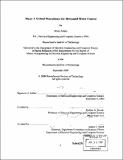Meso : a virtual musculature for humanoid motor control
Author(s)
Adams, Bryan (Bryan Paul), 1977-
DownloadFull printable version (4.591Mb)
Other Contributors
Massachusetts Institute of Technology. Dept. of Electrical Engineering and Computer Science.
Advisor
Rodney A. Brooks.
Terms of use
Metadata
Show full item recordAbstract
Humanoid behavior requires a system with access to humanoid variables. Our humanoid robot, Cog, has two arms that are structurally similar to those of humans; however, the sensory system only provides a sense of strain and position. This thesis describes a model of the human energy metabolism that is linked to the robot's behavior. As the robot uses its arms, the model incorporates the behavior to create a sense of tiredness, fatigue, soreness, or excitement in the robot, both locally at the joints and globally as a part of the overall system. The model also can limit the robot's exertion when appropriate according to the biological system.
Description
Thesis (M.Eng.)--Massachusetts Institute of Technology, Dept. of Electrical Engineering and Computer Science, 2000. Includes bibliographical references (p. 54-55).
Date issued
2000Department
Massachusetts Institute of Technology. Department of Electrical Engineering and Computer SciencePublisher
Massachusetts Institute of Technology
Keywords
Electrical Engineering and Computer Science.